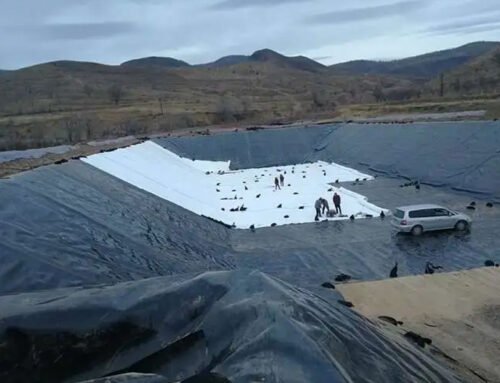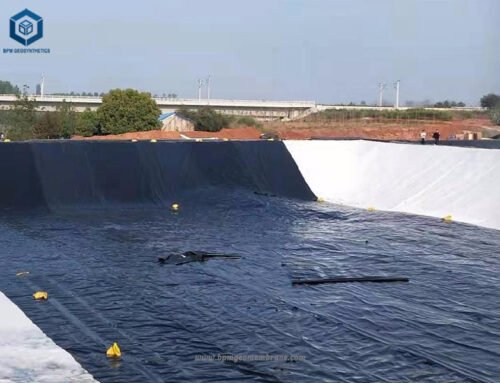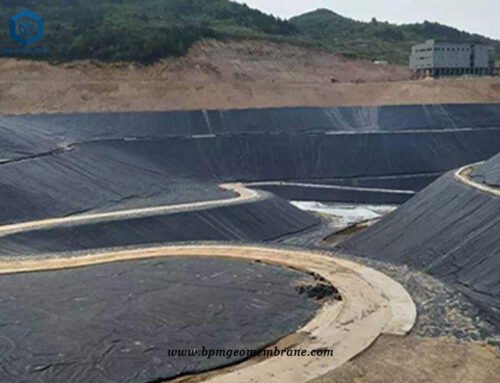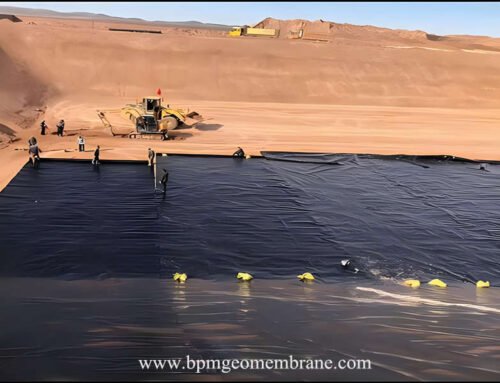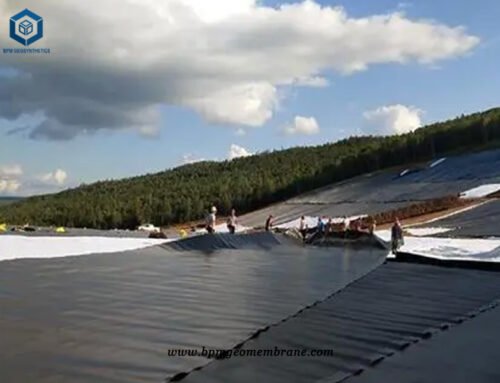PE geomembrane or polyethylene geomembrane is the kind of geomembrane liner designed and engineered with waterporrf, flexibility and long term durability. PE geomembranes are highly suitable for waterproofing applications that demand both flexibility and long-term durability. With exceptional chemical stability, polyethylene is the most commonly employed material for projects involving landfills, tailings ponds, or water treatment basins.
1. What Is PE Geomembrane?
PE geomembrane, short for polyethylene geomembrane, is a high-quality liner made from a polyethylene formula. It typically consists of 97.5% polymer, which provides the main structural component, and 2.5% additives such as black smoke, antioxidants, and heat stabilizers. These additives enhance the geomembrane’s performance by preventing the penetration of UV rays, which can degrade the material over time.
PE geomembranes are renowned for their versatility and effectiveness in preventing fluid migration and ensuring environmental protection. Their flexibility enables them to conform to the shape and contours of the terrain, creating a secure and reliable barrier against the seepage or leakage of fluids. This adaptability is especially beneficial for projects with irregular or complex geometries.
-
High chemical stability
They exhibit resistance to a wide range of aggressive substances, making them well-suited for applications in landfills where they act as a protective barrier, preventing the migration of hazardous materials into the surrounding environment. Similarly, in tailings ponds and water treatment basins, PE geomembranes serve as impermeable layers that safeguard the soil and water resources from contamination.
-
The long-term durability
They can withstand harsh weather conditions, UV exposure, and the stresses associated with installation and usage, maintaining their structural integrity over extended periods of time.
PE geomembranes are reliable and versatile liners made from a polyethylene formula. Their flexibility, chemical stability, and long-term durability make them ideal for preventing fluid migration and providing environmental protection in various applications such as landfills, tailings ponds, and water treatment basins.
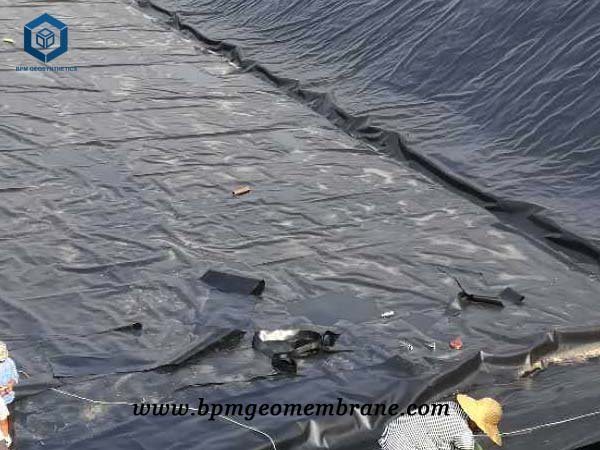

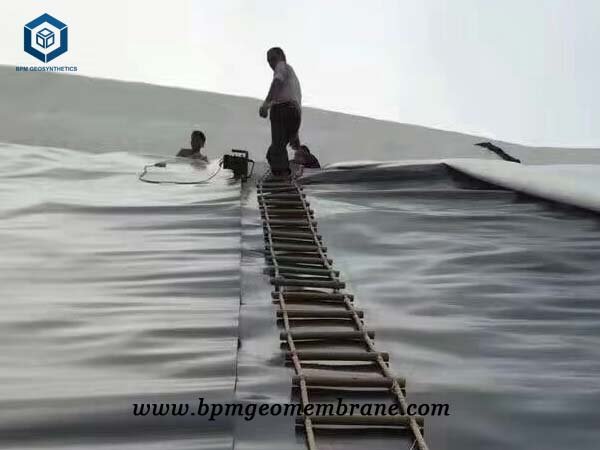
2. What Are Advantages of PE Geomembrane for Landfill?
PE geomembranes are designed with high elongation at break. They resist acids and liquids, preventing environmental contamination. They offer puncture and tear resistance, ensuring durability. Their chemical and thermal resistance is crucial for landfill projects. Elongation resistance and chemical stability enhance performance. Flexibility and impact resistance further contribute to their effectiveness in containing waste materials.
2.1 High elongation at break
PE geomembranes have a high elongation capacity before breaking, allowing them to withstand ground movement and settlement in landfill areas. This flexibility helps prevent damage to the liner and maintain its integrity over time.
2.2 Resistance to acids and most liquids
Landfills contain a wide range of chemical substances and liquids, including acids and leachates. PE geomembranes exhibit excellent resistance to these substances, ensuring long-term protection against chemical degradation and preventing leakage into the surrounding environment.
2.3 Puncture and tear resistance
Landfills can contain sharp objects, debris, and waste materials that may puncture or tear the geomembrane. PE geomembranes offer exceptional puncture and tear resistance, providing a robust barrier against mechanical damage and maintaining the containment of waste materials.
2.4 Very high chemical and thermal resistance level
Landfills often experience exposure to aggressive chemical compounds and high temperatures due to the decomposition of waste. PE geomembranes demonstrate high chemical and thermal resistance, enabling them to withstand these harsh conditions without degradation or compromising their structural integrity.
2.5 High elongation resistance
PE geomembranes have excellent resistance to elongation or stretching, even under the pressure of waste materials and settlement. This characteristic ensures that the geomembrane remains stable and maintains its shape, preventing the formation of wrinkles or gaps that could compromise the landfill’s containment system.
2.6 Chemical stability
PE geomembranes possess high chemical stability, allowing them to resist degradation by chemical reactions and exposure to UV radiation. This stability ensures the long-term effectiveness of the geomembrane in containing the waste and preventing the migration of contaminants into the soil and groundwater.
2.7 Flexible and easy to use
PE geomembranes are flexible and easy to handle, making them convenient for installation in landfill projects. Their flexibility allows them to conform to the contours of the landfill area, including slopes and uneven surfaces. This ease of use facilitates the installation process, reducing time and labor requirements.
2.8 Impact resistance
3. What Is PE Geomembrane Used For?
PE geomembranes are used for a wide range of purposes, including landfill liners, leachate treatment rafts, mining waste containment, water treatment plant linings, retention basins, containment systems in various industries, and civil engineering projects. Their versatility, durability, and impermeable nature make them a reliable solution for waterproofing, containment, and environmental protection in diverse applications.3,
3.1 Landfills
PE geomembranes actively form impermeable barriers in landfill cells, completely isolating waste from surrounding ecosystems. Additionally, their high-density polyethylene composition resists chemical degradation from leachates and acidic compounds. Moreover, these liners undergo rigorous quality testing to ensure zero permeability under extreme pressure and temperature fluctuations. Consequently, they provide fail-safe environmental protection by preventing soil and groundwater contamination for decades.
3.2 Leachate treatment rafts
PE geomembranes actively capture leachate as it filters through landfill waste, preventing uncontrolled dispersal. Additionally, these specialized liners form floating rafts in treatment ponds that concentrate contaminants for efficient removal. Moreover, their chemical-resistant properties withstand aggressive leachate compounds like heavy metals and volatile organics. Consequently, engineers rely on this dual containment-and-collection system to meet strict wastewater treatment regulations.
3.3 Mining waste rafts
PE geomembranes actively contain toxic mining byproducts in tailings ponds, creating critical environmental barriers. Additionally, these high-performance liners prevent heavy metals and acidic drainage from contaminating nearby soil and groundwater systems. Moreover, their engineered durability resists punctures from sharp mining debris while withstanding extreme pH levels. Consequently, mining operators globally implement PE geomembranes as essential safeguards for sustainable resource extraction.
3.4 Water treatment plants
PE geomembranes actively line water treatment basins and reservoirs to maintain critical watertight integrity. Additionally, these impermeable barriers prevent both treated water loss and external contamination from soil or pollutants. Moreover, their NSF-certified formulations ensure safe potable water storage without chemical leaching. Consequently, municipalities and plants rely on PE liners to meet stringent water quality standards while reducing operational costs.
3.5 Retention basins
PE geomembranes actively seal retention basins with zero-permeability barriers that block water infiltration and leakage. Additionally, these engineered liners enable effective stormwater management by preventing uncontrolled runoff during heavy rainfall. Moreover, their durable construction supports flood control systems and long-term water storage applications. Consequently, urban planners and engineers increasingly specify PE geomembranes for resilient water infrastructure projects.
3.6 Containment systems
PE geomembranes actively secure containment systems across petrochemical plants by creating impervious secondary barriers. Additionally, these liners safeguard airport fuel depots and port storage zones from hydrocarbon leaks with chemical-resistant properties. Moreover, industrial facilities implement them to isolate pollutants, preventing soil and water contamination during accidental spills. Consequently, high-risk operations achieve regulatory compliance while minimizing environmental liabilities through these engineered solutions.
3.7 Civil works
PE geomembranes actively waterproof tunnels and retaining walls by forming moisture-resistant barriers that block water ingress. Additionally, these liners enhance roadbed stability in highway construction by preventing soil gas infiltration and subgrade erosion. Moreover, railway projects utilize them to protect embankments from water damage while reducing long-term maintenance needs. Consequently, civil engineers increasingly integrate PE geomembranes as essential waterproofing components in modern infrastructure development.
4. Case Stuy Of PE Geomembrane for Landfill Anti-seepage in Thailand
In Thailand, a landfill anti-seepage project used PE geomembrane. This addressed complex leachate water quality and prevented pollution of soil, rivers, and groundwater. The project was handled by Beijing Environmental Protection Technology Company. The customer was satisfied with BPM’s PE geomembrane production process, raw materials, and product quality.The landfill needed a robust anti-seepage solution due to high organic matter, heavy metal salts, suspended solids (SS), and ammonia nitrogen in the leachate. To meet these needs, the customer chose PE geomembrane as the primary liner material.
The project installed a landfill liner system for 20,000 cubic meters of leachate. A total of 15,000 square meters of PE geomembrane was used. Each roll measured 6 meters by 50 meters. The chosen thickness was 1.5mm, providing strength and impermeability.The project involved stitching geotextile and welding pond liner material.Throughout the project, the customer appreciated ASTM standard adherence and competitive pricing from BPM.
5. About BPM Geomembrane
BPM had provided many types of effective and state of the art geotextile, geomembrane and geosythetics products to over 36 countries. Our main innovative, high quality geosynthetics products include geomembranes, geotextiles, geocell, geosynthetic clay liners (GCLs), drainage boards, geogrids, etc. BPM brand geosynthetics had been certificated by the ISO9001, ISO14001,OHSAS18001 Soncap, SASO and BV certificates and passed the test of SGS and Intertek, etc.
If you have any questions or inquiries, please contact us, we will reply as soon as possible.

